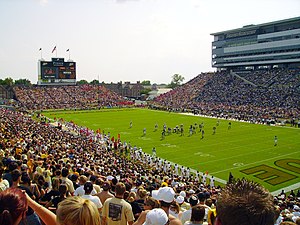Ross-Ade Stadium
| Ross-Ade Stadium | |
|---|---|
| Home of the Boilermakers | |

|
|
| Football game at Ross-Ade Stadium (2006) | |
| Data | |
| place | 850 Steven Beering Drive West Lafayette , Indiana 47907
|
| Coordinates | 40 ° 26 '4 " N , 86 ° 55' 6.3" W |
| owner | Purdue University |
| operator | Purdue University |
| start of building | June 2, 1924 |
| opening | November 22, 1924 |
| Renovations | 2002 |
| Extensions | 1930, 1949, 1955, 1964, 1969 |
| surface | Natural grass |
| costs | 237,500 US dollars (1924) US dollars (2002) 70 million |
| architect | Osborn Engineering Company (1924) HNTB Corporation (2002) |
| capacity | 57,236 places (since 2014) 62,500 places (2003–2013) 66,295 places (2002) 67,332 places (1998–2001) 67,861 places (1988–1997) 69,200 places (1970–1987) 68,000 places (1969) 60,000 places (1964–1968 ) 55,500 places (1955–1963) 51,295 places (1949–1954) 23,074 places (1930–1948) 13,500 places (1924–1929) |
| Societies) | |
The Ross-Ade Stadium is a college football - stadium on the campus of Purdue University in the US city of West Lafayette , Tippecanoe County , in the state of Indiana . It is home to the NCAA college football team of the Purdue Boilermakers ( Big Ten Conference ). It currently offers 57,236 places.
history
Construction of the sports facility in the north corner of the campus began on June 2, 1924. The opening could be celebrated around six months later. It was built to replace Stuart Field, built in 1892, as the home of the Boilermakers football team . The facility for US $ 237,500 with an initial 13,500 seats (including 5,000 additional standing room) bears the names of the stadium's biggest donors, alumni David E. Ross and George Ade . On November 22, on the opening day, the Purdue Boilermakers met the rival of the Indiana Hoosiers of Indiana University Bloomington in Bloomington . The home side won the game 26: 7. In its existence, the Ross-Ade Stadium has been expanded several times. A concrete grandstand was built in 1930 at the northern end zone. With it, the space increased to 23,074. From its completion until the late 1940s, the Ross-Ade Stadium was expanded with temporary stands on the upper edge of the stadium. These were dismantled in 1949 and replaced by steel grandstands. Now the home of the Boilermakers offered 51,295 places. In the following year, the west tier was supplemented with a press stand. In 1955, steel grandstands replaced the tiers that were temporarily set up and brought the capacity to 55,500 visitors. In 1957, the cinder track leading around the pitch was removed and fences were erected in front of the stands.
In 1964 the pitch was lowered by seven feet (around 2.13 meters), which enabled 13 new rows of seats to be built and increased capacity to 60,000. In addition, new paths were laid from the changing rooms to the playing field. In 1968 the last temporary tiers at the north end were exchanged for permanent seating tiers. In addition, the press stand was extended by one level and a new display board was set up at the south end . For the 1969 season, the Ross-Ade Stadium offered 68,000 seats. It reached its highest capacity in 1970 with 69,200 seats, when the south end was increased again by 1,200 seats. In 1975 the pitch was fitted with a drainage system for approximately $ 125,000. The largest crowd in the stadium gathered on November 22, 1980 with a total of 71,629 visitors for the game against the Indiana Hoosiers. In 1985, the home team's changing room under the east stand was renovated. A new changing room was built for the guest team in the southwest corner of the sports arena. In 1990, the old scoreboard was replaced with an electronic system for one million US dollars. The north side received a small board for scores. The fences erected in 1957 were removed in 1994 and the sidewalks there were planted with lawn. After only seven years, the electronic scoreboard was replaced by a $ 3 million JumboTron from Sony .
From 2001 to 2003, the Ross-Ade Stadium underwent a $ 70 million renovation to make the venue more fan-friendly and attractive. The number of places on offer fell from 67,332 to 62,500. In 2002 it had 66,295 seats in the stands. In 2006, the pitch made from Kentucky Bluegrass was replaced with one made from Bermuda Grass , which has deeper roots and is more resistant to cold. The Ross-Ade Stadium was the first Big Ten Conference venue with this grass variety. The following year, a 1.7 million US dollar was on the south end zone video - scoreboard from Daktronics with dimensions of 20.73 x 9.45 meters (68 × 31 foot installed). In 2014, 6,100 places were cut at the southern end. The space is to be used for planned renovations. Since then, the Purdue University stadium has a capacity of 57,236. The last remaining blocks of the original building, Sections 101, 102, and 103 in the southeast corner and Sections 127, 128, and 129 in the southwest corner, were replaced in 2016 for $ 2.8 million.
Ross-Ade Stadium is one of three stadiums of the Big Ten Conference, next to Spartan Stadium at Michigan State University and Ryan Field at Northwestern University , without a permanently installed floodlight system .
Web links
- purduesports.com: Ross-Ade Stadium on the website of the Purdue Boilermakers (English)
Individual evidence
- ↑ news.uns.purdue.edu: Timing and research result in new surface for Purdue football field article from May 19, 2006 (English)
- ↑ purduesports.com: History of the Ross-Ade Stadium (English)
- ↑ indystar.com: 10 items of note in the Ross-Ade Stadium upgrade article from April 15, 2014 (English)